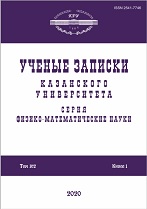|
Qualitative properties of the solution of a conjugate problem of thermal convection
A. A. Azanova, E. N. Lemeshkovab
a Siberian Federal University, Krasnoyarsk, 660041 Russia
b Institute of Computational Modelling, Siberian Branch, Russian Academy of Sciences, Krasnoyarsk, 660036 Russia
Abstract:
The joint convection of two viscous heat-conducting liquids in a three-dimensional layer bounded by flat solid walls was studied. The upper wall is thermally insulated, and the lower wall has a non-stationary temperature field. The liquids are immiscible and separated by a flat interface with complex conjugation conditions set on it. The evolution of this system in each liquid was described by the Oberbeck–Boussinesq equations. The solution of the problem was sought for velocities that are linear in two coordinates and temperature fields that are quadratic functions of the same coordinates. Thus, the problem was reduced to a system of 10 nonlinear integro-differential equations. Its conjugate and inverse nature is determined by the four functions of time. Integral redefinition conditions were set to find them. The physical meaning of the integral conditions is the closeness of the flow. The inverse initial-boundary value problem describes convection near the temperature extremum point on the lower solid wall in a two-layer system. For small Marangoni numbers, the problem was approximated linearly (the Marangoni number is analogous to the Reynolds number in the Navier–Stokes equations). Using the obtained a priori estimates, sufficient conditions were identified for the non-stationary solution to become a stationary one over time.
Keywords:
Oberbeck–Boussinesq model, thermal convection, thermocapillarity, interface, inverse problem, a priori estimates.
Received: 20.09.2023
Accepted: 15.11.2023
Citation:
A. A. Azanov, E. N. Lemeshkova, “Qualitative properties of the solution of a conjugate problem of thermal convection”, Uchenye Zapiski Kazanskogo Universiteta. Seriya Fiziko-Matematicheskie Nauki, 165, no. 4, Kazan University, Kazan, 2023, 326–343
Linking options:
https://www.mathnet.ru/eng/uzku1642 https://www.mathnet.ru/eng/uzku/v165/i4/p326
|

| Statistics & downloads: |
| Abstract page: | 34 | | Full-text PDF : | 7 | | References: | 13 |
|




 Contact us:
Contact us: Terms of Use
Terms of Use
 Registration to the website
Registration to the website Logotypes
Logotypes







 Citation in format
Citation in format 